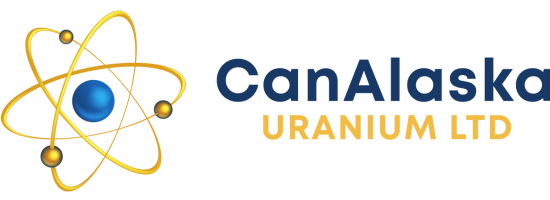Vancouver, Canada, April 19th, 2010 – CanAlaska Uranium Ltd. (TSX.V — CVV) (“CanAlaska” or the “Company”) is pleased to report preliminary drill results from its Collins Bay Extension project, a uranium property under option from Bayswater Uranium. The Winter 2010 drilling at Collins Bay Extension was stopped on April 10th, but was able to test a uranium mineralized target on Fife Island, and then advance to a second, large, well-defined conductivity and gravity anomaly target located due east of the Collins Bay-Eagle Point mine area. In this last target, the Company intersected a new geological feature with uranium mineralization and extensive breccia development.
Additional holes were not able to be completed, due to the conditions of the ice on Lake Wollaston
Collins Bay Fife Island Target:
Four holes were drilled on Fife Island for a total of 539 metres to test the “Vic Zone”. Three of the drill holes tested a historical drill intersection of 0.152% U3O8 over 4 metres at a faulted contact of graphitic metapelite with Archean basement gneiss.
The first three drill holes targeted the approximate location of the historical intersections as well as 20 metres above and below to test the continuity of this type of mineralization. Several mineralized zones were intersected, demonstrating that the mineralization is not restricted to a single point on this sheared contact, (see Table 1 below).
Table 1 – Fife Island Drilling: Mineralized Uranium Intersections

The fourth drill hole at Fife Island targeted another historical intersection in the vicinity, and along the same Archean-Aphebian geological contact. This drill hole showed strongly-fractured and favourable rock from top to bottom, but was lost at 89 metres depth. Down-hole probing was not possible because of drilling problems.
The recovered core shows no anomalous radioactivity, but there was very poor core recovery in several sections, and further evaluation of this target is required.
Blue Island Circular Feature:
The Blue Island target, which is lake-covered, was identified from the VTEM airborne geophysical survey completed in 2007. In-house conversion of the survey data defined two large zones of very high conductivity in basement rocks, each 700 metres x 500 metres in area. These zones are located below conductive lake sediments and straddle an east-west magnetic structural trend. Detailed gravity surveys across the target in January 2010 confirmed a large gravity low associated with each conductive zone.
Drilling commenced on the Blue Island target in mid-March. However, the drilling contractor was unable to complete the first hole on this target, CBX005, and the hole was abandoned. A second drill contractor, Driftwood Diamond Drilling Ltd., was able to commence testing the target in early April, and completed the first of three planned holes, before having to leave the site due to warm weather conditions and failing ice.
The first drill hole into the target is located south-west of Blue Island on the western of the two circular geophysical anomalies (combined conductivity and gravity anomalies, each 500-700 metres in diameter). Drill hole CBX006 was completed in the western portion of the anomaly to a depth of 417 metres. The hole was located in 60 metres of water and penetrated 100 metres of glacial boulder till and varved clay above the basement rocks.
There is strong evidence of an extensive disruptive geological event associated with the circular features from the basement rock cored in drill hole CBX006. The hole penetrated a very long section (257 metres) of heterolithic diatreme breccia containing rafts of various Aphebian and possibly Archean metamorphic rocks together with some granite and diorite. Most of the fragments in the breccia zone are rounded with the rocks in the larger rafts being sheared, chloritised and/or argillized. This brecciation continues to the end of the drill hole.
The overburden-basement interface, is marked by a 3 metre zone of black silty clay, more massive than the varved clay, containing a rounded nodule and angular fragments of pyrite, together with some graphite. The exact depth of this black horizon is uncertain because of long sections of no recovery above and below it. The radiometric probing data shows a marked step-up of the radioactive background at the overburden-basement interface, which starts with a 1,590 cps peak, which, from calibrated tests, corresponds to 1.15 metres at a grade 0.02% eU1 (160.40 to 161.55 metres depth).
A second radioactive peak occurs lower down within the basement breccias. This peak of 895 cps on the calibrated probe corresponds to 0.35 metres at a grade of 0.01% eU1 (238.60 to 238.95 metres depth).
There are additional zones of high background radioactivity corresponding to fault zones, with core loss, between 205-210 metres and between 293-306 metres depth in the basement breccias. Most of these various radioactive peaks have been observed with the calibrated probe, but not on the core recovered. However, there are extensive zones of poor to no core recovery throughout the drill hole.
President Peter Dasler commented, “the Blue Island target is a large new feature in this area of the Athabasca Basin, and we are pleasantly surprised by the amount of breccia intersected in the drill hole. Other areas of the Athabasca Basin have circular structures associated with brecciation, alteration, and uranium mineralization. This is a discrete target, and it is very encouraging the first drill hole has given us evidence of uranium mineralization associated with the breccias. This will be a priority for us to follow-up, and work will continue on the target area over the summer.”
Collins Bay Extension Further Programs:
An extensive ground geophysical Max-Min survey was completed over the Fife Island target during the winter program. This survey identified the strong conductive sedimentary package which trends north-northeast in this area. Additionally, the geophysical surveys over the Blue Island target were matched by other gravity surveys in the Pow Bay area. Pow Bay is immediately up-ice of historical uranium mineralized boulder trains, and is thought to host the source of the mineralized boulders. These geophysical surveys will be used to design follow-up exploration on other targets in the area during the summer exploration season.
Winter Exploration Program Update:
Over the winter exploration season, CanAlaska operated with six drill rigs in the field. Two of these drills were operating at the West McArthur project, a 50/50 Joint Venture with Mitsubishi Corporation. A further two drills were located at the Cree East Project, under a Joint Venture fully-funded by the Korean Consortium of Hanwha Corp., SK Energy Co., Korea Resources Corp. and Korea Electric Power Corp. The fifth drill rig was situated on the Collins Bay Extension project, and a sixth drill completed one hole on the Helmer Lake project. This drill has been left on site in the Fond du Lac area in preparation for summer drilling.
The Qualified Person for this news release is Peter. G. Dasler, P/ Geo.
Note 1. – In this news release ”Equivalent uranium grades” (eU) have been calculated using a dead-time correction and K factor specific to each natural gamma probe based on calibration runs in the Saskatchewan Research Council test pits. Equivalent uranium grade assumes that in these mineralized intersections, the radioactivity is produced by uranium and that there are only negligible amounts of other radioactive elements present.
About CanAlaska Uranium Ltd. — www.canalaska.com
CANALASKA URANIUM LTD. (CVV — TSX.V, CVVUF — OTCBB, DH7 — Frankfurt) is undertaking uranium exploration in twenty 100%-owned and three optioned uranium projects in Canada’s Athabasca Basin — the “Saudi Arabia of Uranium”. Since September 2004, the Company has aggressively acquired one of the largest land positions in the region, comprising over 2,500,000 acres (10,117 sq. km or 3,906 sq. miles). To-date, CanAlaska has expended over Cdn$65 million exploring its properties and has delineated multiple uranium targets.
CanAlaska’s geological expertise and high exploration profile has attracted the attention of major international strategic partners. Among others, Japanese conglomerate Mitsubishi Corporation has provided the Company C$11 mil. in exploration funding to earn a 50% ownership interest in the West McArthur Project. Exploration of CanAlaska’s Cree East Project is also progressing under a C$19 mil. joint venture with a consortium of Korean companies led by Hanwha Corporation, and comprising Korea Electric Power Corp., Korea Resources Corp. and SK Energy Co, Ltd., in which the Korean Consortium presently holds a 40.6% ownership interest. Other Company projects in the Athabasca Basin scheduled for drill testing during this winter 2010 season include McTavish, Collins Bay Extension and Helmer.
On behalf of the Board of Directors
“Peter Dasler”
Peter Dasler, P. Geo., President & CEO
Contact:
Emil Fung, Director & V.P. – Corp. Dev.
Tel: +1.604.688.3211
Email: info@canalaska.com
The TSX Venture has not reviewed and does not accept responsibility for the adequacy or accuracy of this release: CUSIP# 13708P 10 2. This news release contains certain “Forward-Looking Statements” within the meaning of Section 21E of the United States Securities Exchange Act of 1934, as amended. All statements, other than statements of historical fact, included herein are forward-looking statements that involve various risks and uncertainties. There can be no assurance that such statements will prove to be accurate, and actual results and future events could differ materially from those anticipated in such statements. Important factors that could cause actual results to differ materially from the Company’s expectations are disclosed in the Company’s documents filed from time to time with the British Columbia Securities Commission and the United States Securities & Exchange Commission.

